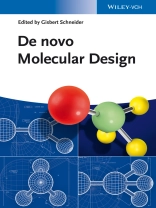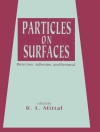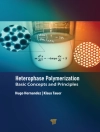Systematically examining current methods and strategies, this ready reference covers a wide range of molecular structures, from organic-chemical drugs to peptides, Proteins and nucleic acids, in line with emerging new drug classes derived from biomacromolecules.
A leader in the field and one of the pioneers of this young discipline has assembled here the most prominent experts from across the world to provide first-hand knowledge. While most of their methods and examples come from the area of pharmaceutical discovery and development, the approaches are equally applicable for chemical probes and diagnostics, pesticides, and any other molecule designed to interact with a biological system. Numerous images and screenshots illustrate the many examples and method descriptions.
With its broad and balanced coverage, this will be the firststop resource not only for medicinal chemists, biochemists and biotechnologists, but equally for bioinformaticians and molecular designers for many years to come.
From the content:
* Reaction-driven de novo design
* Adaptive methods in molecular design
* Design of ligands against multitarget profiles
* Free energy methods in ligand design
* Fragment-based de novo design
* Automated design of focused and target family-oriented compound libraries
* Molecular de novo design by nature-inspired computing
* 3D QSAR approaches to de novo drug design
* Bioisosteres in de novo design
* De novo design of peptides, proteins and nucleic acid structures, including RNA aptamers
and many more.
Table des matières
Foreword
Preface
DE NOVO DESIGN: FROM MODELS TO MOLECULES
Molecular Representation
The Molecular Design Cycle
Receptor-Ligand Interaction
Modeling Fitness Landscapes
Strategies for Compound Construction
Strategies for Compound Scoring
Flashback Forward: A Brief History of De Novo Drug Design
Conclusions
COPING WITH COMPLEXITY IN MOLECULAR DESIGN
Introduction
A Simple Model of Molecular Interactions
Enhancements to the Simple Complexity Model
Enumerating and Sampling the Complexity of Chemical Space
Validation of the Complexity Model
Reductionism and Drug Design
Complexity and Information Content as a Factor in De Novo Design
Complexity of Thermodynamic Entropy and Drug Design
Complex Systems, Emergent Behavior, and Molecular Design
THE HUMAN POCKETOME
Predicted Pockets
Compilation of the Validated Human Pocketome
Diversity and Redundancy of the Human Pocketome
Compound Activity Prediction by Ligand-Pocket Docking and Scoring
Pocketome-Derived 3D Chemical Fields as Activity Prediction Models
Clustering the Ligands by Function and Subpockets
Conclusions
STRUCTURE-BASED DE NOVO DRUG DESIGN
Introduction
Current Progress in SBDND Methodologies
Recent Applications of Structure-Based De Novo Design
Perspectives and Conclusion
DE NOVO DESIGN BY FRAGMENT GROWING AND DOCKING
Introduction
Case Study I: High-Throughput Screening with Dr Feils
Case Study II: Fragment-Based Drug Design with Dr Goode
Conclusion
HIT AND LEAD IDENTIFICATION FROM FRAGMENTS
Introduction to FBDD
Fragment Library Design Incorporating Computational Methods
Fragment Screening
Fragment Prioritization for Optimization
Fragment Hit Expansion and Fragment Evolution
Fragment Merging Principles
Fragment Linking Principles
Fragment-Assisted Drug Discovery (FADD)
Conclusion
PHARMACOPHORE-BASED DE NOVO DESIGN
Introduction
A Summary of the Algorithms of Ph DD v1.0
An Introduction to the Modifications in the Updated Version of Ph DD (v2.0)
Validation of Ph DD
Concluding Remarks
3D-QSAR APPROACHES TO DE NOVO DRUG DESIGN
Introduction
Current Methods
Leapfrog
Recent Advances
Conclusions
LIGAND-BASED MOLECULAR DESIGN USING PSEUDORECEPTORS
Introduction
Pseudoreceptor Algorithms
Successful Applications Overview
Conclusions
REACTION-DRIVEN DE NOVO DESIGN: A KEYSTONE FOR AUTOMATED DESIGN OF TARGET FAMILY-ORIENTED LIBRARIES
Introduction
Reaction-Driven Design: Tackling the Problem of Synthetic Feasibility
Successful Applications of Reaction-Driven De Novo Design
Reaction-Driven Design of Chemical Libraries Addressing Target Families
Conclusions
MULTIOBJECTIVE DE NOVO DESIGN OF SYNTHETICALLY ACCESSIBLE COUMPOUNDS
Introduction
Design of Synthetically Accessible Compounds
Synthetic Accessibility Using Reaction Vectors
De Novo Design Using Evolutionary Algorithms
Conclusions
DE NOVO DESIGN OF LIGANDS AGAINST MULTITARGET PROFILES
Introduction
Automating the Creativity of Ligand Design
Evolutionary Algorithm
Experimental Validation
Reducing Antitarget Activity
Optimizing D4 Receptor Potency
Designing Novel Ligands to a Defined Profile
Conclusion
CONSTRUCTION OF DRUG-LIKE COMPOUNDS BY MARKOV CHAINS
Introduction
FOG Algorithm and Library Generation
Applications
Conclusion
COPING WITH COMBINATORIAL SPACE IN MOLECULAR DESIGN
Introduction
Chemical Space
Combinatorial Space
Visualization
Conclusion
FRAGMENT-BASED DESIGN OF FOCUSED COMPOUND LIBRARIES
Introduction
General Workflow
Fragment Space
Query
FTrees Fragment Space Search
Scaffold Selection
Design of Focused Libraries
Application Example
Summary and Conclusions
FREE ENERGY METHODS IN LIGAND DESIGN
Free Energy (FE) Methods in Lead Optimization (LO)
The Variety of In Silico Binding Affinity Methods
The Choice of a Method for Calculating Binding FE
Experimental Data
Current Issues
Practical Examples
Miscellaneous Issues
Best Practices
Conclusions and Outlook
BIOISOSTERES IN DE NOVO DESIGN
Introduction
History of Isosterism and Bioisosterism
Methods for Bioisosteric Replacement
Exemplar Applications
Conclusions
PEPTIDE DESIGN BY NATURE-INSPIRED ALGORITHMS
Template-Based Design
Nature-Inspired Optimization
Worked Example: De Novo Design of MHC-I Binding Peptides by Ant Colony Optimization
Chemical Modification
Conclusions and Outlook
DE NOVO COMPUTATIONAL PROTEIN DESIGN
Introduction
Elements of Computational Protein Design
Efforts in Theoretically Guided Protein Design
Conclusion
DE NOVO DESIGN OF NUCLEIC ACID STRUCTURES
Introduction
DNA-Branched Structures
Scaffolded DNA Origami Design
Alternative DNA Designs: Between Junctions and Origami
Conclusions
RNA APTAMER DESIGN
Aptamers and Design
Riboswitches and Aptamers
SELEX
Speeding Up SELEX by Computational Methods
Structures and Probing Methods
Functional Analyses (In Vitro and In Vivo)
Problems
Future Perspectives
Index
A propos de l’auteur
Gisbert Schneider is full professor of computer-assisted drug design at ETH Zurich, Switzerland. He studied biochemistry and computer science at the Free University of Berlin, Germany. After several international postdoctoral research activities he joined F. Hoffmann-La Roche Pharmaceuticals in Basel, Switzerland, where he headed the cheminformatics group. From 2002-2009 he was full professor of cheminformatics and bioinformatics (Beilstein Endowed Chair) at Goethe-University Frankfurt, Germany. Professor Schneider coined the terms ‘scaffold-hopping’ and ‘frequent hitter’ in drug design. His research activities concentrate on method development for adaptive molecular design and their tight integration with innovative chemical and biophysical techniques in drug discovery.












